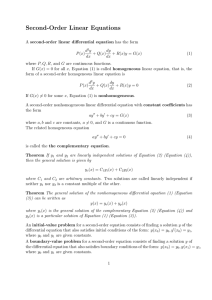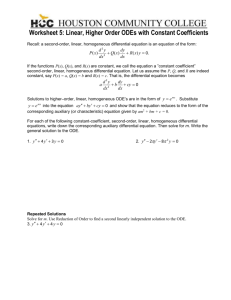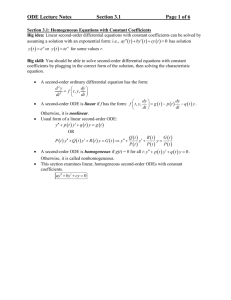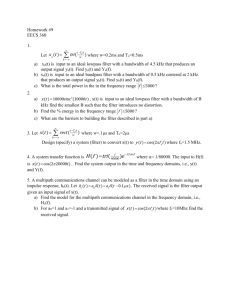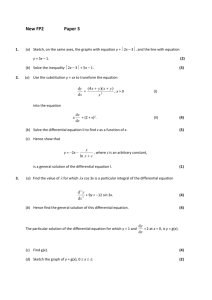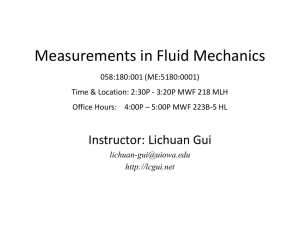EET 159 PowerPoint Slides
advertisement
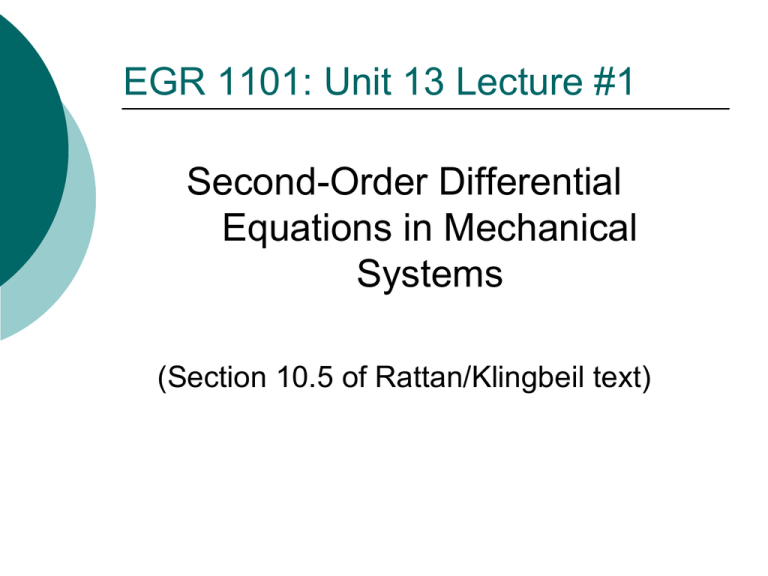
EGR 1101: Unit 13 Lecture #1
Second-Order Differential
Equations in Mechanical
Systems
(Section 10.5 of Rattan/Klingbeil text)
Review: Procedure
Steps in solving a linear ordinary
differential equation with constant
coefficients:
1.
2.
3.
4.
Find the transient solution.
Find the steady-state solution.
Find the total solution by adding the results of
Steps 1 and 2.
Apply initial conditions (if given) to evaluate
unknown constants that arose in the previous
steps.
Forcing Function = 0?
Recall that if the forcing function (the righthand side of your differential equation) is
equal to 0, then the steady-state solution is
also 0.
In such cases, you get to skip straight from
Step 1 to Step 3!
Second-Order Equations
General form of a 2nd-order linear ordinary
diff. equation with constant coefficients:
𝑑2𝑦
𝑑𝑦
𝑎 2 +𝑏
+ 𝑐𝑦 𝑡 = 𝑓(𝑡)
𝑑𝑡
𝑑𝑡
Two factors that affect how much work is
involved in solving a particular instance:
1.
2.
How simple or complicated is f(t)?
Are a, b, and c such that b2−4ac is negative? If
so, the solution will involve imaginary numbers.
Imaginary Numbers?
In solving some second-order linear
ordinary differential equations with
constant coefficients, you’ll get imaginary
numbers as you work through Step #1
(transient solution).
To simplify your solution in such situations,
use Euler’s identity:
e
j
cos j sin
Today’s Examples
1.
2.
Free vibration of a spring-mass system
Forced vibration of a spring-mass system
MATLAB Commands for Example
#2
>>fplot('1/(1-0.9^2)*(cos(0.9*t)-cos(t))', [0 200])
To investigate the system’s behavior as the
forcing frequency approaches the system’s
natural frequency, change the two
occurrences of 0.9 in this command to 0.99,
and then change to 0.999.
Resonance at work
Glass shattered by resonance:
http://www.youtube.com/watch?v=17tqXgvCN0E
Tacoma Narrows Bridge collapse:
http://www.youtube.com/watch?v=3mclp9QmCGs
EGR 1101: Unit 13 Lecture #2
Second-Order Differential
Equations in Electrical
Systems
(Section 10.5 of Rattan/Klingbeil text)
Low-Pass and High-Pass Filters
A low-pass filter is a circuit that passes
low-frequency signals and blocks highfrequency signals.
A high-pass filter is a circuit that does
just the opposite: it blocks low-frequency
signals and passes high-frequency
signals.
Today’s Examples
1.
Second-order low-pass filter
Mechanical-Electrical Analogy
Governing equation of forced spring-mass
system from previous lecture:
m y ky ( t ) F cos( t )
Initial conditions: y ( 0 ) 0 , y ( 0 ) 0
Governing equation of our second-order
filter:
LC v v ( t ) V cos( t )
Initial conditions: v ( 0 ) 0 , v ( 0 ) 0
Mechanical-Electrical Analogy
(Continued)
Solution of forced spring-mass system from
previous lecture:
F
y (t )
2
k m
cos( t ) cos
k
t
m
Solution of our second-order filter:
V
v (t )
cos(
t
)
cos
2
1
LC
t
LC
1
